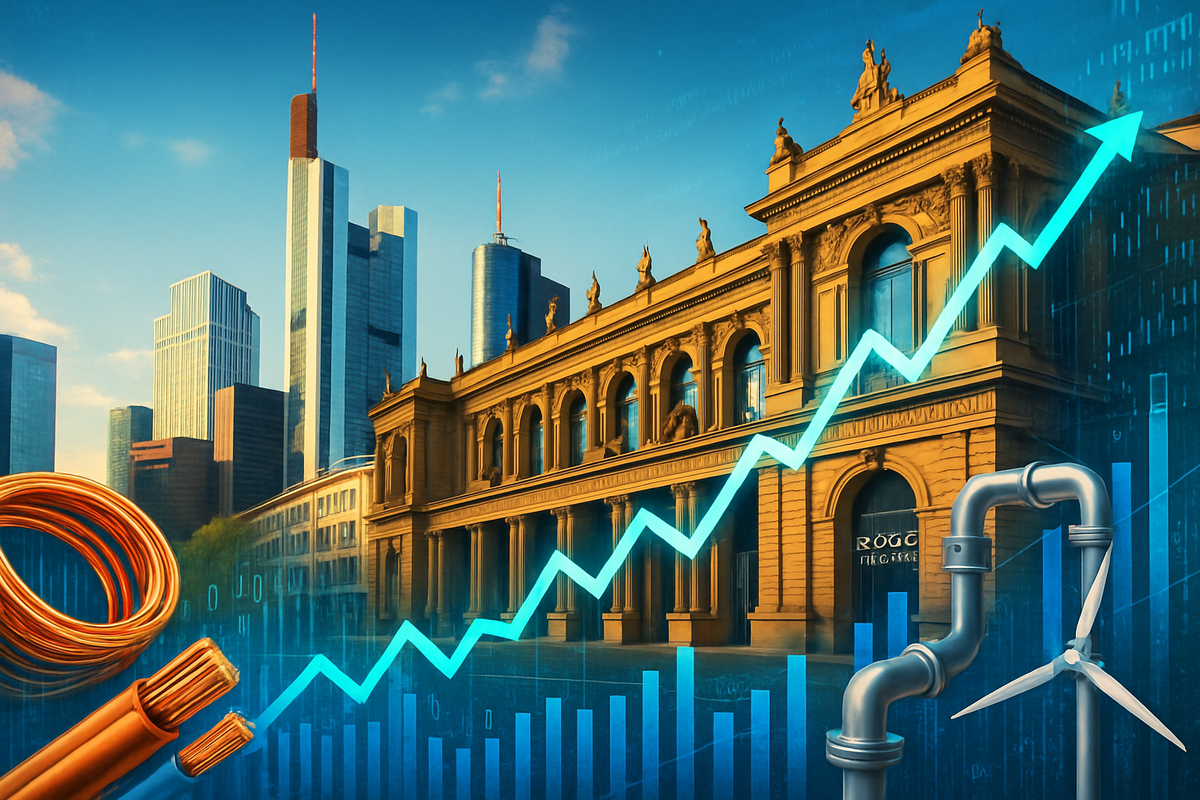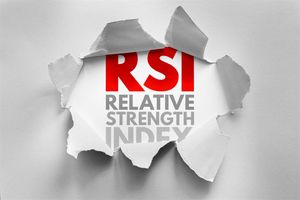
Frankfurt's benchmark DAX index (XTRA:DAX) closed on October 2, 2025, at 24,422.56 points, just shy of its all-time high, signaling unprecedented buoyancy across the European market. This remarkable performance, driven by a confluence of robust fiscal policies, accommodative monetary stances, and a global tech rally, paints a picture of renewed confidence in the continent's economic resilience. However, while a strong European market typically suggests a surge in industrial commodity demand, the current landscape presents a complex and somewhat contradictory outlook, with certain sectors poised for growth while others face significant headwinds.
DAX's Ascent: A Detailed Look at Europe's Buoyant Market
The DAX's ascent has been nothing short of spectacular throughout 2025, having already surged over 20% year-to-date by May and nearly 22% by July, even breaching the significant 20,000-point mark earlier in the year. The closing figure on October 2, 2025, represented a 1.28% gain for the day and marked the index's fourth-highest close in history, extending a five-day winning streak. This brought it within striking distance of its all-time high of 24,641.50, recorded in July 2025, and merely 0.52% off its record close of 24,549.56 on July 9, 2025. This strong start to October has ignited hopes for a robust year-end rally, shaking off what was perceived as a "lethargic September."
Several potent forces have converged to fuel this impressive rally. Aggressive fiscal stimulus from the German government, notably a €500 billion plan over 12 years targeting defense and infrastructure, has injected substantial capital into the economy. Concurrently, the European Central Bank (ECB) adopted an accommodative stance earlier in 2025, cutting interest rates to 2% due to slowing inflation, making equities more attractive. Although the ECB held rates steady in late September 2025 amid inflation concerns, the earlier cuts were a significant catalyst.
Globally, the technology and artificial intelligence (AI) rally has been a paramount driver, with European chip-related giants like ASML Holding N.V. (AMS:ASML) and ASM International N.V. (AMS:ASM) experiencing substantial gains. Optimism surrounding anticipated interest rate cuts by the U.S. Federal Reserve, which began an easing cycle in September 2025, has also provided a crucial tailwind. Furthermore, German stocks are widely considered undervalued compared to international counterparts, boasting a price-to-earnings ratio of 15 against the S&P 500's 21, attracting significant capital inflows from investors reportedly shifting funds from US markets to European equities due to geopolitical uncertainties. Lower energy prices and Germany's strong economic fundamentals—including export-led growth, a stable current account surplus, population growth from immigration, and rising labor participation—have further solidified the positive outlook.
The broader European market sentiment around October 2, 2025, was one of "unprecedented buoyancy" and "widespread market strength." The pan-European STOXX Europe 600 Index (STOXX:SXXP) reached an intraday record high of 568.5 points on the same day, reflecting renewed confidence. However, this optimism is somewhat tempered by underlying factors. Germany's annual inflation rate climbed to 2.4% in September 2025, complicating future ECB policy. While Eurozone GDP rebounded by 1.4% in Q3 2025, Germany's growth was described as "fragile." The overall Eurozone economic outlook for 2025 remains subdued, with projected growth around 1% due to trade policy uncertainties and a potential US government shutdown. There are also signs that European outperformance might be losing steam as US markets rally, leading some European investors to reconsider US stock ETFs.
Winners and Losers in a Shifting Landscape
A strong European market, particularly one buoyed by technology and infrastructure spending, creates a mixed bag for public companies, especially concerning industrial commodity demand.
Potential Winners:
- Semiconductor and Tech Companies: European chip giants like ASML Holding N.V. (AMS:ASML) and ASM International N.V. (AMS:ASM) are direct beneficiaries of the global AI and technology rally. Their continued growth is expected to drive demand for specialized materials, but their primary driver is technology adoption rather than broad industrial commodity volume.
- Companies in the Energy Transition Sector: Firms involved in renewable energy infrastructure, electric vehicle manufacturing, and battery technology stand to gain significantly. The research highlights strong demand for copper, a critical mineral for the energy transition. This benefits mining companies with significant copper assets (e.g., Rio Tinto (ASX:RIO), Glencore (LSE:GLEN) if they have European operations or supply chains) and manufacturers of related components.
- Natural Gas Suppliers and Infrastructure: With a bullish outlook for natural gas (Henry Hub) in Q4 2025, driven by increased U.S. LNG exports to Europe and Europe's efforts to phase out Russian LNG, companies involved in natural gas production, transport, and regasification infrastructure (e.g., Uniper SE (XTRA:UN01), RWE AG (XTRA:RWE)) could see increased demand and profitability.
- Defense and Infrastructure Contractors: The German government's €500 billion spending plan on defense and infrastructure will directly benefit construction companies, engineering firms, and defense contractors operating in Germany and the wider EU.
- Financials and Consumer Discretionary: A buoyant market and positive consumer sentiment, coupled with an accommodative ECB policy, generally bode well for banks (e.g., Deutsche Bank AG (XTRA:DBK), Commerzbank AG (XTRA:CBK)) and companies in the consumer discretionary sector (e.g., Volkswagen AG (XTRA:VOW3), Mercedes-Benz Group AG (XTRA:MBG)), assuming consumer confidence translates into spending.
Potential Losers/Challengers:
- Traditional Industrial Manufacturers: While overall market sentiment is positive, the eurozone's manufacturing sector faces structural headwinds, including high energy prices and intense competition from China. Companies in traditional manufacturing (e.g., some heavy machinery manufacturers, basic materials producers beyond critical minerals) might see slower demand for their raw materials if overall industrial activity outside of specific growth areas remains subdued or shifts away from traditional heavy industry.
- Chemicals Industry: The European chemicals industry faces a double whammy: new U.S. tariffs of 15% on exports to the US and higher energy/feedstock costs due to geopolitical conflicts. This leads to slowing demand and reduced competitiveness, impacting major players like BASF SE (XTRA:BAS) or Covestro AG (XTRA:1COV).
- Broad Industrial Metals Producers (excluding copper): While copper demand is strong, overall industrial metals are projected to decline through 2026. Companies heavily reliant on other industrial metals (e.g., steel, aluminum) might face pricing pressures and reduced demand, especially with protectionist trade policies dampening global industrial activity.
- Companies with High Energy Input Costs: Despite lower energy prices being a general tailwind for the DAX, some sectors, particularly heavy industry, remain vulnerable to energy price volatility. Any resurgence in prices could quickly erode margins.
Wider Significance and Global Ripple Effects
The DAX's current performance near record highs is more than just a localized stock market phenomenon; it's a significant indicator of broader shifts within the European economy and global financial landscape. This strong showing, particularly amidst global uncertainties, highlights a potential divergence from traditional growth drivers and underscores the increasing importance of specific sectors.
Firstly, the emphasis on robust fiscal stimulus and a technology-driven rally signals a strategic pivot in European economic policy and investment. Germany's substantial infrastructure and defense spending plan suggests a commitment to bolstering domestic capabilities and security, which could have long-term implications for industrial growth and employment. The outperformance of European chip-related companies like ASML (AMS:ASML) and ASM International (AMS:ASM) underscores Europe's critical role in the global technology supply chain, particularly in advanced manufacturing, and its potential to benefit from the ongoing AI revolution. This fits into a broader trend of technological advancement driving market gains, even as traditional sectors face challenges.
Secondly, the nuanced outlook for industrial commodities reflects the complexities of global trade and the accelerating energy transition. While overall commodity prices are projected to decline, the strong demand for copper, driven by electric vehicles and renewable energy infrastructure, highlights a significant structural shift. This means that commodity-producing nations and companies globally will increasingly need to differentiate between "legacy" industrial metals and those critical for the green economy. For instance, countries heavily reliant on traditional metal exports might face headwinds, while those with abundant reserves of critical minerals could see increased investment and demand. This also has ripple effects on partners, as countries supplying these critical minerals (e.g., Chile for copper) will see their economies tied more closely to Europe's green ambitions.
Thirdly, regulatory and policy implications are profound. The ECB's accommodative stance earlier in 2025, followed by a rate freeze, illustrates the delicate balancing act central banks face between stimulating growth and containing inflation. Germany's rising inflation rate to 2.4% in September 2025 will undoubtedly pressure the ECB to reconsider its monetary policy, potentially impacting borrowing costs and investor sentiment in the future. Furthermore, protectionist trade policies, such as new U.S. tariffs on EU imports and EU's reduced steel import quotas, are creating barriers to global industrial activity. These policies not only dampen demand for certain commodities but also force companies to reassess their supply chains and production locations, potentially leading to reshoring or nearshoring efforts within Europe. The challenges faced by the European chemicals industry due to tariffs and energy costs serve as a stark reminder of these policy impacts.
Historically, periods of strong European market performance have often coincided with robust global economic growth, leading to broad-based commodity demand. However, the current situation presents a more selective demand profile, akin to previous periods where specific technological advancements or infrastructure booms drove targeted commodity consumption rather than a general surge. The current environment, characterized by geopolitical uncertainties and a push towards decarbonization, suggests that historical precedents might offer limited direct comparisons, emphasizing the unique nature of this market cycle.
The Road Ahead: Opportunities, Challenges, and Scenarios
The DAX's impressive performance near record highs sets the stage for a dynamic period, presenting both opportunities and challenges for the European market and its impact on industrial commodity demand.
In the short-term, the market will be closely watching for continued strength in the technology sector and the impact of the German government's fiscal stimulus. The anticipated U.S. Federal Reserve rate cuts in October 2025 could provide further tailwinds for global equities, including the DAX, by reducing borrowing costs and encouraging capital flows. However, the rising inflation rate in Germany and the nuanced stance of the ECB will be critical. Any hawkish shift from the ECB could temper market enthusiasm. For industrial commodities, the immediate future points to continued strong demand for critical minerals like copper, driven by ongoing energy transition projects. Natural gas prices are also expected to remain bullish in Q4 2025 due to European demand for LNG. Conversely, traditional industrial metals and sectors like chemicals may continue to face pressures from trade policies and structural challenges.
Looking long-term, the trajectory of the DAX and European commodity demand will be shaped by several key factors. The ongoing global energy transition will be a dominant force, creating sustained demand for specific minerals and technologies. This could lead to strategic pivots for mining companies to focus on these "future-proof" commodities and for manufacturers to adapt their product lines. The evolution of trade relations, particularly between the EU and the US, will significantly influence industrial activity and commodity flows. Should protectionist policies intensify, it could further fragment global supply chains and lead to more regionalized demand patterns.
Potential market opportunities include increased investment in renewable energy infrastructure, electric vehicle manufacturing, and advanced technology sectors within Europe. Companies that can innovate and adapt to these shifts, leveraging sustainable practices and efficient supply chains, are likely to thrive. Challenges include managing inflationary pressures, navigating geopolitical risks (such as ongoing conflicts in Eastern Europe and the Middle East that could impact energy and fertilizer prices), and addressing the structural headwinds in traditional manufacturing.
Several scenarios could unfold. In an optimistic scenario, continued technological innovation, successful implementation of green policies, and a resolution of trade tensions could lead to sustained European economic growth and a broad-based, albeit differentiated, increase in industrial commodity demand. A pessimistic scenario might see inflation spiral, central banks forced into aggressive rate hikes, and escalating trade wars, leading to an economic slowdown that dampens both market sentiment and commodity demand across the board. A middle-ground scenario suggests continued selective growth, with tech and green sectors flourishing while traditional industries face ongoing adjustments, leading to highly specific commodity demand patterns. Investors should prepare for a market that is increasingly sector-specific and sensitive to geopolitical and policy developments.
Conclusion: A Market in Transition
The DAX's rally to near-record highs on October 2, 2025, stands as a testament to the resilience and evolving dynamics of the European market. Key takeaways from this event underscore a shift in market drivers: robust fiscal intervention, an accommodative, though increasingly cautious, European Central Bank, and the undeniable force of global technological advancement, particularly in AI and semiconductors. This confluence has created a buoyant environment for European equities, with the pan-European STOXX Europe 600 Index also reaching new highs.
Moving forward, the market presents a dichotomy. While overall European economic sentiment is positive, the implications for industrial commodity demand are highly nuanced. The accelerating global energy transition emerges as a critical driver, ensuring strong demand for specific minerals like copper, which are essential for electric vehicles and renewable infrastructure. Similarly, natural gas demand, especially for European LNG imports, is projected to remain robust. However, traditional industrial metals and sectors like chemicals face headwinds from protectionist trade policies, structural challenges in manufacturing, and a projected broader decline in overall commodity prices through 2026.
The lasting impact of this period will likely be a more diversified and specialized European economy, less reliant on traditional heavy industry and more focused on high-tech manufacturing, green technologies, and services. Investors should watch closely for the ECB's future monetary policy decisions in light of rising inflation, the evolution of international trade agreements, and further government initiatives supporting infrastructure and green transitions. Monitoring the performance of key technology players and companies positioned to benefit from the energy transition will be crucial.
This content is intended for informational purposes only and is not financial advice





